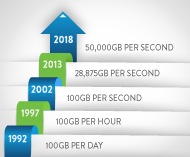What we can learn from Amazon’s success
Humans have generated data, in one form or another, from the time that cave dwellers started painting about the activities in their daily lives. Today, we generate data at a pace where the space required to store it is as big as some of the largest manmade structures.

According to a recent study by Ben Walker of Voucher Cloud, 2.5 quintillion bytes of data are created every day, and this unimaginable number is still growing at an exponential rate. We created data at the rate of only 100GB daily in 1992, which increased to 100GB per hour by 1997. By 2002, the same amount of data was generated every second. Carrying on the same theme, PwC estimates that by 2020 there will be 20 times more usable data than there is today.
That’s 20 times 2.5 quintillion bytes of data per day.
So what does this data have to do with Amazon? And why is a recent article in The Wall Street Journal calling data the big win in Amazon’s acquisition of Whole Foods? (At the time of writing this piece, there are others, like Walmart, trying to jump into the sweepstakes.)
Over the past two decades, Amazon started by changing the way the world buys books and then disrupted the entire landscape of the retail industry. And the secret sauce is data.
One big reason for Amazon’s success is that they figured out how to effectively use their data to understand consumer behavior and stay a step ahead of their competitors. Leveraging the vast trove of information collected on its own consumers’ buying history, Amazon patented a mechanism called Predictive Shipping—a process that allows them to send packages before the customer even clicks “Buy”.
Faster delivery helps Amazon prevent a customer from purchasing the same article from a brick-and-mortar store. The Wall Street Journal article contends that Amazon has spent years working on more ways to gather information on how consumers shop. If the deal with Whole Foods goes through, Amazon, much as it did in the digital retail industry, its predictive model will govern what goods to carry in each store.
As Amazon has clearly demonstrated, with the vast amounts of data generated today, the rewards for executing a successful strategy are significant. For financial institutions, big data gains come in many categories—from converting customers making loan payments from other institutions, to laser-focused staffing strategies built around predictive transaction volume.
Cheaper storage and digitization of data has made it easy to generate, gather and store vast amounts of data. And those who figure out a way to put the data to use will be the ones who succeed tomorrow.

